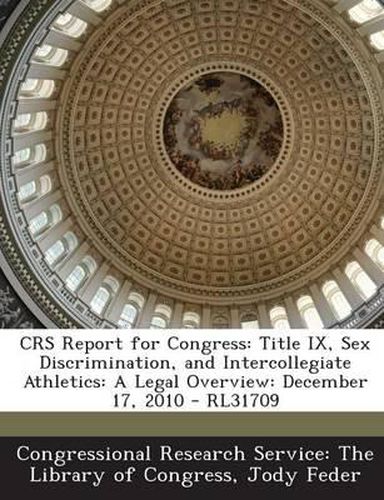Readings Newsletter
Become a Readings Member to make your shopping experience even easier.
Sign in or sign up for free!
You’re not far away from qualifying for FREE standard shipping within Australia
You’ve qualified for FREE standard shipping within Australia
The cart is loading…






Enacted nearly four decades ago, Title IX of the Education Amendments of 1972 prohibits discrimination on the basis of sex in federally funded education programs or activities. Although the Title IX regulations bar recipients of federal financial assistance from discriminating on the basis of sex in a wide range of educational programs or activities, such as student admissions, scholarships, and access to courses, the statute is perhaps best known for prohibiting sex discrimination in intercollegiate athletics. Indeed, the provisions regarding athletics have proved to be one of the more controversial aspects of Title IX. At the center of the debate is a three-part test that the Department of Education (ED) uses to determine whether institutions are providing nondiscriminatory athletic participation opportunities for both male and female students. Proponents of the existing regulations point to the dramatic increases in the number of female athletes in elementary and secondary school, college, and beyond as the ultimate indicator of the statute’s success in breaking down barriers against women in sports. In contrast, opponents contend that the Title IX regulations unfairly impose quotas on collegiate sports and force universities to cut men’s teams in order to remain in compliance. Critics further argue that the …
$9.00 standard shipping within Australia
FREE standard shipping within Australia for orders over $100.00
Express & International shipping calculated at checkout
Enacted nearly four decades ago, Title IX of the Education Amendments of 1972 prohibits discrimination on the basis of sex in federally funded education programs or activities. Although the Title IX regulations bar recipients of federal financial assistance from discriminating on the basis of sex in a wide range of educational programs or activities, such as student admissions, scholarships, and access to courses, the statute is perhaps best known for prohibiting sex discrimination in intercollegiate athletics. Indeed, the provisions regarding athletics have proved to be one of the more controversial aspects of Title IX. At the center of the debate is a three-part test that the Department of Education (ED) uses to determine whether institutions are providing nondiscriminatory athletic participation opportunities for both male and female students. Proponents of the existing regulations point to the dramatic increases in the number of female athletes in elementary and secondary school, college, and beyond as the ultimate indicator of the statute’s success in breaking down barriers against women in sports. In contrast, opponents contend that the Title IX regulations unfairly impose quotas on collegiate sports and force universities to cut men’s teams in order to remain in compliance. Critics further argue that the …